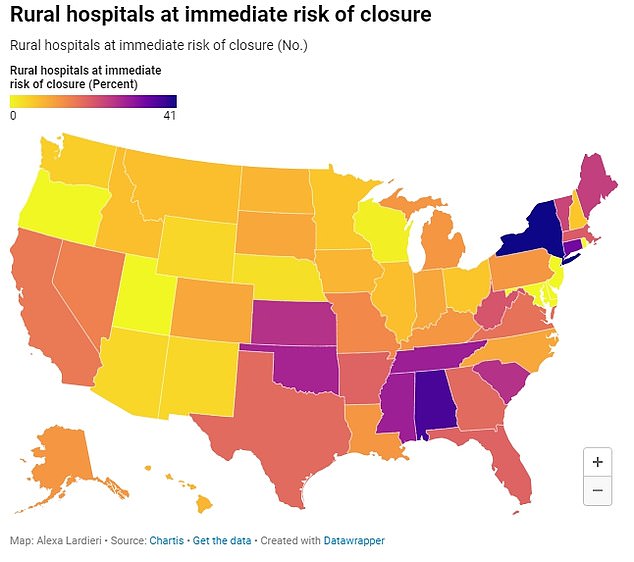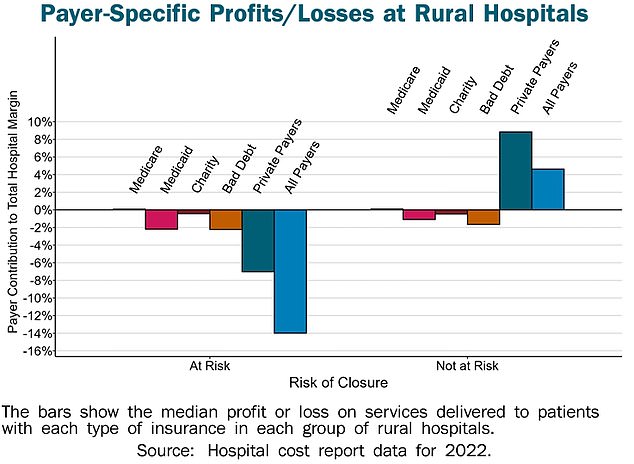Analysis shows nearly 500 rural hospitals serving millions of Americans are at risk of closing… is yours on the chopping block?
More than 600 hospitals serving millions of Americans in rural areas are at risk of closure, according to a new report that is prompting experts to “sound the alarm.”
More than half of these hospitals are at risk of closing immediately.
Rural hospitals are at risk of closing in almost every state, but higher numbers are being seen in the Southeast and Northeast.
The facilities are at risk because they face much greater financial challenges in treating patients and providing care due to staff shortages and smaller payouts from health insurers.
An analysis of Chartisa Chicago health care consulting firm, found that the state at risk of the most closures was Texas, where 75 of its rural hospitals – 47 percent – could close and 28 hospitals – 18 percent – are at risk of immediate closure .
There are approximately 2,200 rural hospitals in the U.S. that an estimated 60 million Americans rely on for basic health care.
In more than half of states, 25 percent or more are at risk, and in 15 states, nearly half of rural hospitals are at risk.
In five states — Utah, Rhode Island, New Jersey, Maryland and Delaware — no rural hospitals are at risk of closure.
After Texas, Kansas is at risk of losing 58 rural hospitals (57 percent), while 27 or 26 percent are at risk of having to close operations immediately.
Kansas currently has 102 rural hospitals, with 911,000 residents believed to live in rural areas.
Oklahoma is at risk of losing 33 rural hospitals (42 percent), while nearly twenty percent (28 percent) are in immediate danger.
Over the past two decades, national spending on hospital services has tripled and is expected to continue to rise even faster in the coming years due to inflation, supply chain issues and workforce shortages.
The report found that the main reason hospitals are at risk of closing is because private insurance companies pay them less than what it costs to treat patients, causing rural facilities to lose money on their patient services.
They also lose money to Medicaid patients and patients who don’t have health insurance.
Rural hospitals also have lower financial reserves than urban hospitals and cannot compensate for the losses they face. The percentage of U.S. rural hospitals operating at a loss now stands at 50 percent – up from 43 percent last year.
In addition, all hospital assistance that began during the Covid pandemic has been halted. Because of that financial assistance during the pandemic, there were not as many rural hospital closures in 2021 and 2022 as in 2019.
While 18 hospitals closed during the pandemic in 2020, researchers attributed this to financial difficulties the facilities were already experiencing before Covid.


The biggest area where rural hospitals lose money comes from private insurers. They also lose money to Medicaid patients and patients who don’t have health insurance
The Chartis analysis did not specify which hospitals are at risk, but facts Saving Rural Hospitals, which is run by the Center for Healthcare Quality and Payment Reform, shows that there are hundreds of hospitals operating at financial losses.
In Texas, about 110 hospitals are losing money on health care services to patients, including Yoakum County Hospital, which is operating with the largest deficit in the state (and nation) at -72 percent.
The second largest hospital in the state (and country) is Cochran Memorial Hospital, with a patient margin of -61 percent over the past three years.
Rounding out the top five nationwide are Welch Community Hospital in West Virginia; Thomasville Regional Medical Center in Alabama; and Reagan Memorial Hospital in Texas.
While some rural hospitals may not be at risk of being closed completely, many have stopped providing some basic services.
Gynecological care services were discontinued at 25 percent (267) of rural facilities between 2011 and 2021.
And 387 stopped giving chemotherapy between 2014 and 2021.
The authors of the Chartis report said: ‘Significant changes need to be made to both the amounts and methods of payment for rural hospital services to prevent more rural hospitals from closing in the future.’
Although payments are sufficient to cover the cost of services in larger, more urban facilities, these payments will not cover hospital costs in rural areas because there are far fewer patients to be treated (and billed) relative to the fixed costs of operating of a hospital.
When rural hospitals close due to a lack of finances, it threatens more than just access to healthcare.
The Chartis researchers said: ‘The closure of rural hospitals threatens the country’s food supply and energy production because farms, ranches, mines, drilling sites, wind farms and solar energy facilities are mainly located in rural areas and they will not be able to attract and retain people. workers if the workers cannot receive adequate health care.”
In rural areas, people face challenges in traveling or accessing healthcare due to the scarcity of hospitals compared to urban areas.
Nearly two-thirds of rural hospitals are more than thirty kilometers away from the nearest hospital and a quarter are thirty kilometers or more away.
In urban hospitals, the majority are located within eight kilometers of each other, while more than 80 percent are within a radius of fifteen kilometers of another hospital.
The census depicts rural areas as an area with fewer than 50,000 residents and classifies 19 percent of Americans – 60 million people – as living in rural areas.
Small rural hospitals are defined as hospitals with annual expenditures of less than $40 million.
Rural hospitals provide many of the same services as urban facilities, including emergency services, basic laboratory testing and imaging, as well as outpatient and inpatient services.
However, they do it at a much lower volume.
Most rural hospitals have fewer than 25 beds, compared to more than 200 beds in urban hospitals.
Half of urban hospitals have expenses of more than $250 million, but only two percent of rural hospitals operate with that much money.
Due to a lack of access to health care, hospitals in rural communities are often the source of primary care for residents in addition to their emergency services. The closure of a rural hospital means people will have to travel further to receive medical services or miss out on important basic or preventative care.
